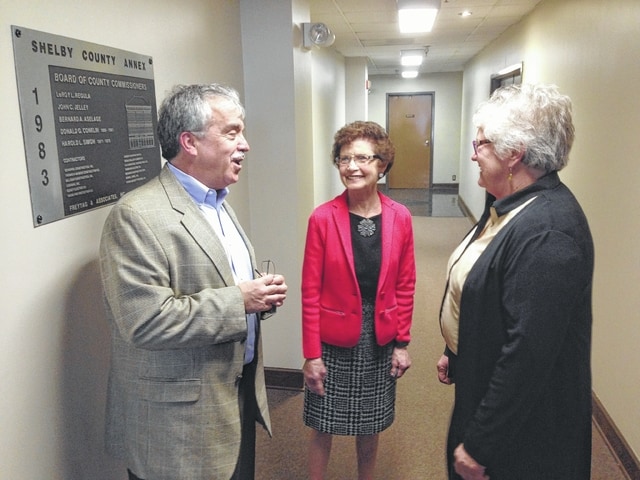
SIDNEY — The Shelby County Commissioner’s meeting room was crowded with representatives of townships, villages and the city of Sidney for the initial discussion of the steps necessary to create a county land bank. The meeting, scheduled by Shelby County Treasurer Linda Meininger, was held March 24.
Meininger introduced former Cuyahoga County Treasurer Jim Rokakis. Rokakis is currently the vice president of the Western Reserve Land Conservancy.
Rokakis and Robin Thomas, director of the Western Reserve Land Conservancy Land Bank, used a 33 slide powerpoint presentation to help the attendees better understand the steps that will need to be taken locally to establish a county land reutilization corporation (land bank).
Rokakis reviewed Ohio’s challenges, which include the decline in population that created vacant properties, predatory lending practices that led to foreclosures and the loss of home equity that resulted from bursting housing bubble.
“Shelby County traditionally had fewer than 50 foreclosures a year,” Rokakis said. “By 1999, the number had increased to more than a hundred, and steadily climbed through 2009 when there were more than 300 foreclosures. Fortunately, the number has slowly but steadily declined to about 130 foreclosures a year.”
Rokakis said Cuyahoga County was the first county to be authorized by the state legislature to forma a land bank, primarily due to the decline in the number of residents in Cleveland. “Cleveland’s population went from more than 900,000 people to 396,815 in the 2010 census,” Rokakis said. “When the folks left, they didn’t take their houses with them, and as a result, we had a lot of abandoned homes.”
“The General Assembly amended the law in 2010 to allow counties with populations of at least 60,000 to establish land banks,” Rokakis said. “In September 2015, the state legislature passed a bill that would allow the establishment of a land bank in any county in Ohio.”
Thus far, 29 counties have established land banks. Another 21 counties including Shelby County have expressed interest in establishing a land bank.
The benefits of a county land bank, as outlined by Thomas, are numerous. Land banks can:
1. Take control of vacant and abandoned, tax delinquent properties;
2. Reduce flipping;
3. Repurpose properties through demolition or rehabilitation; transfer properties to qualified end users; and,
4. Put abandoned properties back on the tax rolls.
Thomas touted land banks as being recognized as the preferred entity to handle vacant properties. Land banks can enter into agreements with the Federal National Mortgage Association, HUD, and banks. She also advised that Neighborhood Initiative Program funds amounting to $347 million would only be available to counties that have land banks.
To establish a land bank, the county commissioners would need to pass a resolution to create a Land Reutilization Corporation and authorize the county treasurer to file Articles of Incorporation with the Secretary of State. Once that has been accomplished, the commissioners would need to pass a second resolution designating the Land Reutilization Corporation as an agent of the county and directing the Land Reutilization Corporation to develop an agreement and plan of operation.
There would then be an organizational meeting of the newly established board in which the Code of Regulations, the agreement and plan of operation would be approved. By law, the board would consist of five, seven or nine members. It would include the county treasurer, two county commissioners, a representative of the largest city, and others chosen by agreement between the treasurer and the county commissioners, at least one of whom must have applicable experience.
“The board,” Rokakis said, “would set policies for acquisition, demolition, rehabilitation, disposition and other similar activities. They would also approve contracts and handle other fiscal issues, and hire staff to run the land bank. That staff could work directly for the board or through agreement with the county commissioners, auditor or treasurer.”
The Land Reutilization Corporation is funded through direct contributions from the county, grants and a portion of the Delinquent Tax and Assessment Collection Fee (DTAC). “In most counties, land banks are funded through the DTAC fee,” Rokakis said.
Rokakis and Thomas answered a number of questions. A show of hands reflected that nearly everyone in the room was in favor of proceeding with the development of a land bank. A meeting was set for early next week between county and city officials to continue working to establish a land bank.
“I thought that the meeting went well,” Meininger said. “The Commissioners and I have discussed the idea of a land bank for some time. It would appear that we could obtain a substantial amount of money for Shelby County to tear down abandoned buildings, and work to get those properties back on the tax rolls.”
Sidney Mayor Mike Barhorst was enthusiastic about the response that those attending the meeting showed. He had previously spoken to both Meininger and the county commissioners about the urgency of establishing a land bank so that the county would qualify for the Neighborhood Initiative Program funds that are due to be released in about three months.
“It is my understanding that if we have a county land bank, we will qualify for an initial grant in the amount of $500,000, and an additional $25,000 for each property we identify as foreclosed,” said Barhorst. “While this would benefit Sidney tremendously, every village mayor except one has indicated that they have one or more properties that would potentially meet the criteria and need to come down.”
“From talking with some of the township trustees, it is clear that most of the townships would also benefit from the establishment of a land bank,” Barhorst said. “Hopefully they will see the wisdom of moving forward as well.”
This will benefit all of us, city and county,” Commissioner Robert Guillozet said at the conclusion of the meeting.
The establishment of a Land Reutilization Corporation is expected to take four to eight weeks.


